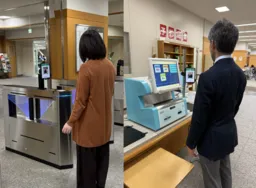

Osaka University Libraries Implement Cutting-Edge Facial Recognition Technology for Enhanced User Experience
Osaka University Libraries Adopt Advanced Facial Recognition Technology
In a groundbreaking initiative, Osaka University has become the first national university in Japan to implement state-of-the-art facial recognition technology across all four of its affiliated libraries. This project, in collaboration with Kinokuniya Co., Ltd. and Panasonic Connect, aims to enhance user experience for the approximately 30,000 students and faculty members, providing them with seamless access to library facilities.
Overview of the Initiative
The integration of facial recognition technology will begin with automated entrance gates and self-service borrowing and returning machines by May 2025. The adoption of this technology aligns with the university's commitment to improve campus life through efficient management of library resources, particularly through the OUID system. This system provides a unified identification platform for current, incoming, and alumni students, creating a lifelong ID for easy access to university resources.
High Standards of Facial Recognition
Osaka University’s libraries serve over 950,000 visitors annually and handle more than 330,000 book borrowings each year. Until now, access required students to present physical student IDs, which excluded some faculty members who had to apply for separate library access permits. This new system will eliminate such barriers, making it more convenient for everyone within the university community.
The facial recognition system, provided by Panasonic Connect, is praised for its top-ranking precision, ensuring secure and reliable user identification. This advanced facial recognition technology, which achieved first place in international evaluations conducted by NIST, will enable users to enter libraries and check out books without fumbling for cards.
Security and Management Improvements
By linking personal data from current students, faculty, graduates, and applicants with the OUID system, the university aims to streamline library operations and enhance security measures. With a focus on user convenience, the system will automatically manage entry as well as borrowing, allowing users to access resources much more efficiently.
Additionally, QR code readers will complement the facial recognition system, ensuring that both traditional and digital Student ID cards can be used interchangeably, thereby accommodating diverse user needs.
Future Expansion
Looking ahead, Osaka University plans to use facial recognition technology for various educational and administrative functions, including access control for classrooms, meeting rooms, and attendance monitoring for classes and examinations. This initiative not only signifies a shift towards modernizing library services but also enhances the overall user experience, representing a significant step in the digital transformation of educational institutions.
In conclusion, as Osaka University embraces this innovative technology, it emerges as a leader in enhancing educational engagement and resource accessibility, reflecting the ongoing advancements in digital technology within academic environments. The comprehensive approach to integrating this facial recognition system hints at a future where educational institutions can offer not only higher security but also enriched, user-friendly services to their communities.




Topics Other)










【About Using Articles】
You can freely use the title and article content by linking to the page where the article is posted.
※ Images cannot be used.
【About Links】
Links are free to use.